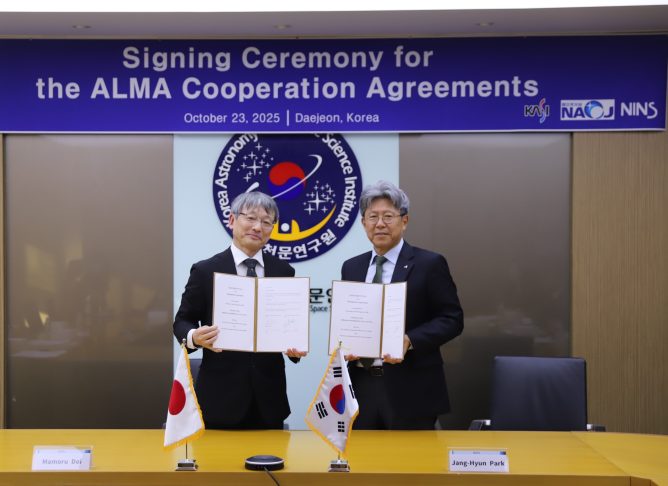The first 7-m antenna passed the acceptance review and was handed over to the Joint ALMA Observatory (JAO) on May 2, 2011. The antenna is the first of the twelve 7-m antennas to be manufactured by Japan, and its handover is an important milestone toward the start of the regular operation of ALMA.
ALMA is a giant radio interferometer of 66 parabola antennas, consisting of 54 antennas of 12 m diameter, and twelve 7-m antennas. ALMA-Japan is in charge of manufacturing 16 (four 12-m antennas and twelve 7-m antennas) of 66 antennas. The Japanese antennas are manufactured in Japan and disassembled before shipment to Chile. After arriving in Chile, the antennas are assembled into an integrated system and go through numerous adjustments and tests in the Site Erection Facility area at the ALMA Operations Support Facility (OSF) at 2,900 m asl. After detailed evaluation tests including astronomical observations by NAOJ and the acceptance review, the antennas are finally handed over to JAO.
As to the four 12-m antennas manufactured by Japan, the first one was handed over to JAO at the end of 2008 as the first ALMA antenna, and remaining three have been subsequently accepted
(December 19, 2008, “Handover of the First Antenna to the Joint ALMA Observatory”) .
The first 7-m antenna, handed over this time, will go through installation of receivers, comprehensive receiver evaluation test and commissioning by JAO before transported to the ALMA Array Operations Site (AOS) at 5,000 m asl, where regular scientific observations are conducted.
ALMA East Asian Antenna Team Leader, Junji Inatani (Professor at NAOJ ALMA-J Project Office) says, “In the production phase, various inventions have been incorporated into the design of the 7-m antenna to complete twelve equally-high-performance antennas while adopting technologies proved with the 12-m antennas. In addition to this, smaller diameter of the 7-m antenna has contributed to higher accuracy. We have a long way to go before completing and handing over all of twelve antennas to JAO, but the acceptance of the first 7-m antenna gave us a bright prospect for the future.”
These 16 Japanese antennas compose the system called Atacama Compact Array (ACA) and nicknamed “IZAYOI”. The ACA system is a very important component to measure the intensity of radio waves emitted from astronomical objects precisely.
In radio interferometers like ALMA, radio waves are received by multiple antennas and synthesized by computer so as to work as a single giant telescope; expanding the dimension of the array corresponds to enlarging the aperture (diameter) of a telescope. The radio interferometer has the advantage of being able to achieve higher resolution by increasing the distance between antennas when observing detailed structures. On the other hand, such distant antenna configuration is not suitable for observation of extended and blurred objects like clouds. For this kind of observation, it is necessary to make compact antenna configuration with smaller ACA 7-m antennas, because the 12-m antennas manufactured by North America and Europe cannot be positioned within a distance of 15 meters to avoid collision.
Furthermore, the four ACA 12-m antennas, which are used as a part of an array in the Early Science Operation, will be used as a single radio telescope capable of measuring the intensity of radio waves emitted from target objects during the regular operation. Combining three different types of antennas, ALMA will acquire improved observation capability for extended objects, and achieve the highest resolution and sensitivity ever achieved.
ALMA is a global partnership of East Asia, Europe, and North America in cooperation with the Republic of Chile.
Photo 1: 7-m antenna on the transporter being moved from the Site Erection Facility area
[photographed by Masumi Yamada (NAOJ)].

Photo 2: 7-m antenna transported to OSF [photographed by Masao Saito(NAOJ)].










